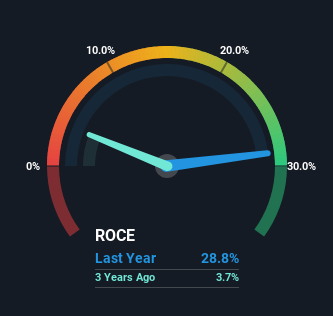V.I.P. Industries (NSE:VIPIND) Will Be Hoping To Turn Its Returns On Capital Around
If you're looking for a multi-bagger, there's a few things to keep an eye out for. Firstly, we'd want to identify a growing return on capital employed (ROCE) and then alongside that, an ever-increasing base of capital employed. This shows us that it's a compounding machine, able to continually reinvest its earnings back into the business and generate higher returns. Having said that, while the ROCE is currently high for V.I.P. Industries (NSE:VIPIND), we aren't jumping out of our chairs because returns are decreasing.
Understanding Return On Capital Employed (ROCE)
For those that aren't sure what ROCE is, it measures the amount of pre-tax profits a company can generate from the capital employed in its business. Analysts use this formula to calculate it for V.I.P. Industries:
Return on Capital Employed = Earnings Before Interest and Tax (EBIT) ÷ (Total Assets - Current Liabilities)
0.29 = ₹2.3b ÷ (₹14b - ₹6.3b) (Based on the trailing twelve months to June 2023).
Thus, V.I.P. Industries has an ROCE of 29%. That's a fantastic return and not only that, it outpaces the average of 10% earned by companies in a similar industry.
Check out our latest analysis for V.I.P. Industries

In the above chart we have measured V.I.P. Industries' prior ROCE against its prior performance, but the future is arguably more important. If you'd like to see what analysts are forecasting going forward, you should check out our free report for V.I.P. Industries.
What The Trend Of ROCE Can Tell Us
On the surface, the trend of ROCE at V.I.P. Industries doesn't inspire confidence. Historically returns on capital were even higher at 43%, but they have dropped over the last five years. However, given capital employed and revenue have both increased it appears that the business is currently pursuing growth, at the consequence of short term returns. And if the increased capital generates additional returns, the business, and thus shareholders, will benefit in the long run.
Another thing to note, V.I.P. Industries has a high ratio of current liabilities to total assets of 44%. This can bring about some risks because the company is basically operating with a rather large reliance on its suppliers or other sorts of short-term creditors. Ideally we'd like to see this reduce as that would mean fewer obligations bearing risks.
Our Take On V.I.P. Industries' ROCE
In summary, despite lower returns in the short term, we're encouraged to see that V.I.P. Industries is reinvesting for growth and has higher sales as a result. In light of this, the stock has only gained 14% over the last five years. So this stock may still be an appealing investment opportunity, if other fundamentals prove to be sound.
One more thing to note, we've identified 3 warning signs with V.I.P. Industries and understanding these should be part of your investment process.
If you want to search for more stocks that have been earning high returns, check out this free list of stocks with solid balance sheets that are also earning high returns on equity.
New: Manage All Your Stock Portfolios in One Place
We've created the ultimate portfolio companion for stock investors, and it's free.
• Connect an unlimited number of Portfolios and see your total in one currency
• Be alerted to new Warning Signs or Risks via email or mobile
• Track the Fair Value of your stocks
Have feedback on this article? Concerned about the content? Get in touch with us directly. Alternatively, email editorial-team (at) simplywallst.com.
This article by Simply Wall St is general in nature. We provide commentary based on historical data and analyst forecasts only using an unbiased methodology and our articles are not intended to be financial advice. It does not constitute a recommendation to buy or sell any stock, and does not take account of your objectives, or your financial situation. We aim to bring you long-term focused analysis driven by fundamental data. Note that our analysis may not factor in the latest price-sensitive company announcements or qualitative material. Simply Wall St has no position in any stocks mentioned.
About NSEI:VIPIND
V.I.P. Industries
Manufactures and retails luggage, backpacks, handbags, and accessories in India and internationally.
Reasonable growth potential with mediocre balance sheet.
Similar Companies
Market Insights
Community Narratives




